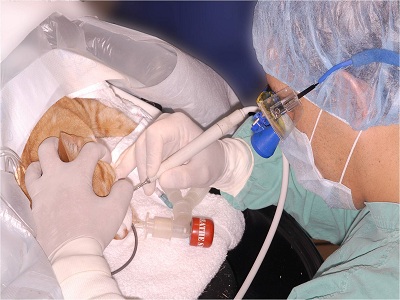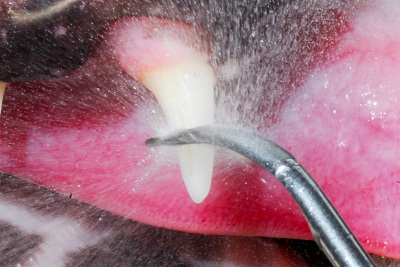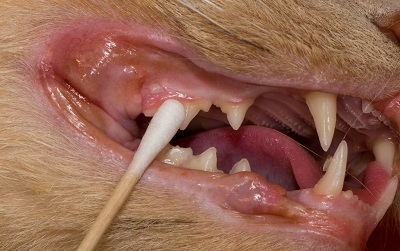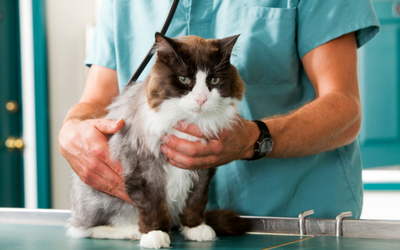Home | Dental Care | Dental Cleaning in Cats: Essential Oral Care
Dental Cleaning in Cats: Essential Oral Care
Keywords:
When rough tartar accumulates on tooth surfaces and touches the gum line, it is time for a professional oral assessment, treatment, and prevention visit.
What is involved with a dental exam?
An examination by your veterinarian is the first step. Your veterinarian will confirm that a dental cleaning is needed and will review with you what procedures are likely required prior to the dental cleaning.
Since it can be difficult to predict the extent of dental disease in advance of the procedure, it is imperative that your veterinarian be able to reach you during the procedure to discuss any additional treatment that may be necessary.
Your veterinarian may perform pre-anesthetic blood tests to ensure that kidney and liver function are satisfactory for anesthesia (see handout "Preanesthetic Bloodwork" for more information), as well as an evaluation of the heart and abdomen if needed.
Featured Resources

We Welcome New Patients!
We're always happy to give your furry friend care at our hospital. Get in touch today!
Contact UsGeneral Information:
Playing with other animals is not allowed during confinement. If there are other pets in your household, you will need to keep them separated.
During confinement, your pet's food intake needs to be reduced to help prevent weight gain. Most dogs will maintain their current weight if their food intake is cut in half. Water consumption should remain normal.
The first two weeks following surgery you will need to monitor your pet's incisions. Licking or chewing can cause infection or sutures to loosen. If you notice that your pet has started licking, you will need to take steps to discourage it from doing so.
It takes a minimum of six to eight weeks for bones to heal.
One of the most difficult aspects of confinement is that the animals will frequently feel better long before they are healed. At this point your pet will start being more careless of the operated limb and is then more likely to be overactive and injure itself. Until the bone is healed, you must adhere strictly to the confinement guidelines and not allow your pet to do more.
If your pet is jumping or bouncing in its confined area, it is being too active. Tranquilizers may be required to help alleviate your pet's anxiety or control its activity.
If at any time during your pet’s recovery and healing it does anything that causes it to cry out or give a sharp yelp, contact your veterinarian.
Following surgery your pet should always maintain at its current level of function, or improve. If at any time during your pet's recovery and healing it has a setback or decrease in function, contact your veterinarian.
It is imperative that you inform your veterinarian at once if your pet does something that is potentially harmful to the surgery. If something has occurred which jeopardizes the outcome of surgery, it is usually less difficult to correct if it is caught right away, which leads to a better outcome for your pet.
If your pet is too active during its confinement it may injure itself or slow healing which increases the amount of time your pet must be confined.
Follow up appointments are usually needed two weeks post-operatively to monitor incisions and healing. At eight weeks post-operatively radiographs are taken at which time your pet is started on a regulated activity regime. A final appointment at four months post-operatively is needed for additional radiographs and final instructions before returning your pet to normal activity.

How are my cat’s teeth cleaned?
After the mouth is evaluated and diseased teeth are noted on your cat’s medical chart, tooth scaling will be performed, using both hand and ultrasonic scalers, to remove tartar above and below the gum line. The tartar below the gum line causes the most significant periodontal disease, so its removal is important.
If periodontal disease is advanced, it may not be possible to save badly affected teeth. These teeth will need to be extracted.
After scaling, the teeth are polished to decrease the rate of subsequent plaque build-up. Sealer application is recommended to decrease plaque accumulation.

Why can't tartar and plaque be removed with a human dental scaler?
Although you can remove some of the accumulated tartar on the tooth that is visible in cats that are cooperative, there are three problems with doing this:
Only the visible tartar is removed. This leaves plaque and tartar below the gum line which will continue to cause periodontal problems.
It is neither possible nor safe to clean the inner surfaces of the teeth properly in a conscious cat.
The use of any instrument on the tooth enamel will cause microscopic scratches on the surface which will ultimately damage the tooth surface, leading to further disease - this is the reason your dental hygienist always polishes your teeth after removing tartar with dental instruments.

Do I have to make an appointment for my cat to have a dental scaling and polishing?
Yes. Your veterinarian will perform pre-anesthetic tests and examine your pet for underlying disorders prior to the procedure and may determine that antibiotic treatment should be prescribed in advance.
How can I prevent tartar accumulation after the procedure?
Plaque and tartar begin forming in as little as six hours after your cat's dental cleaning. A home dental care program is a must. Your veterinarian will provide you with detailed instructions on how to brush or rinse your cat's teeth. Plaque and tartar accumulation can be decreased by rubbing a Q-tip along the gum line daily.
The Veterinary Oral Health Council (VOHC) only accepts dental products that are safe and proven to reduce the accumulation of plaque and tartar based on strict scientific studies. A list of accepted products can be viewed at www.VOHC.org and your veterinarian can advise you as well.
Can I use human toothpaste?
Absolutely not. Human dentifrice or toothpaste should never be used in cats. Human teeth cleaning detergents contain ingredients that are not intended to be swallowed and can cause stomach problems in cats. You should also avoid using baking soda to clean your cat's teeth. Baking soda has a high alkaline content and, if swallowed, it can upset the acid balance in the stomach and digestive tract. In addition, baking soda does not taste good, which may cause your cat to be uncooperative when you try to brush her teeth.
Why is pet toothpaste recommended?
Pet toothpaste is considered safe to be swallowed and is available in flavors that are appealing to cats including poultry, beef, malt, and mint. If you use a product that tastes good, your cat will be more likely to enjoy the whole experience. In addition to the pleasant taste, many of these pet-friendly toothpaste contain enzymes that are designed to help break down plaque chemically, which reduces the time you need to actually spend brushing your cat's teeth.
Contributors: Jan Bellows, DVM, Dipl. AVDC, ABVP
Featured Resources

We Welcome New Patients!
We're always happy to give your furry friend care at our hospital. Get in touch today!
Contact UsTips and Advice from Our Team
Looking for advice about caring for your pet? Our blog features helpful tips and educational material from our team to support your needs.



